Recent Advances in the Preparation and Application of Two-Dimensional Nanomaterials
Abstract
:1. Introduction
2. Primary Morphology Parameters of 2D NMs
2.1. Size
2.2. Thickness
2.3. Surface Defects
3. Preparation of 2D NMs
3.1. Top-Down Method
3.1.1. Mechanical Peeling
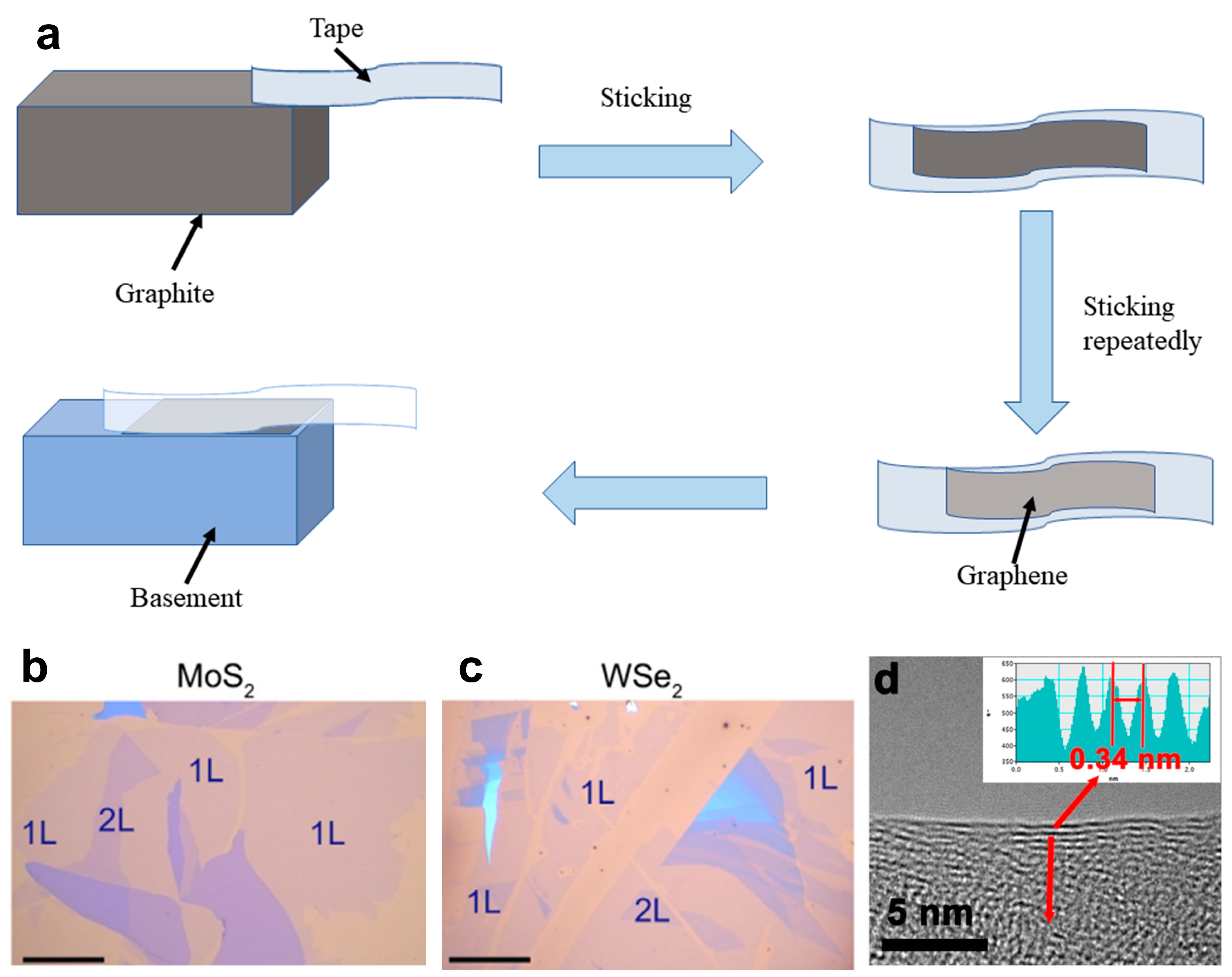
3.1.2. Ultrasonic-Assisted Liquid Phase Exfoliation
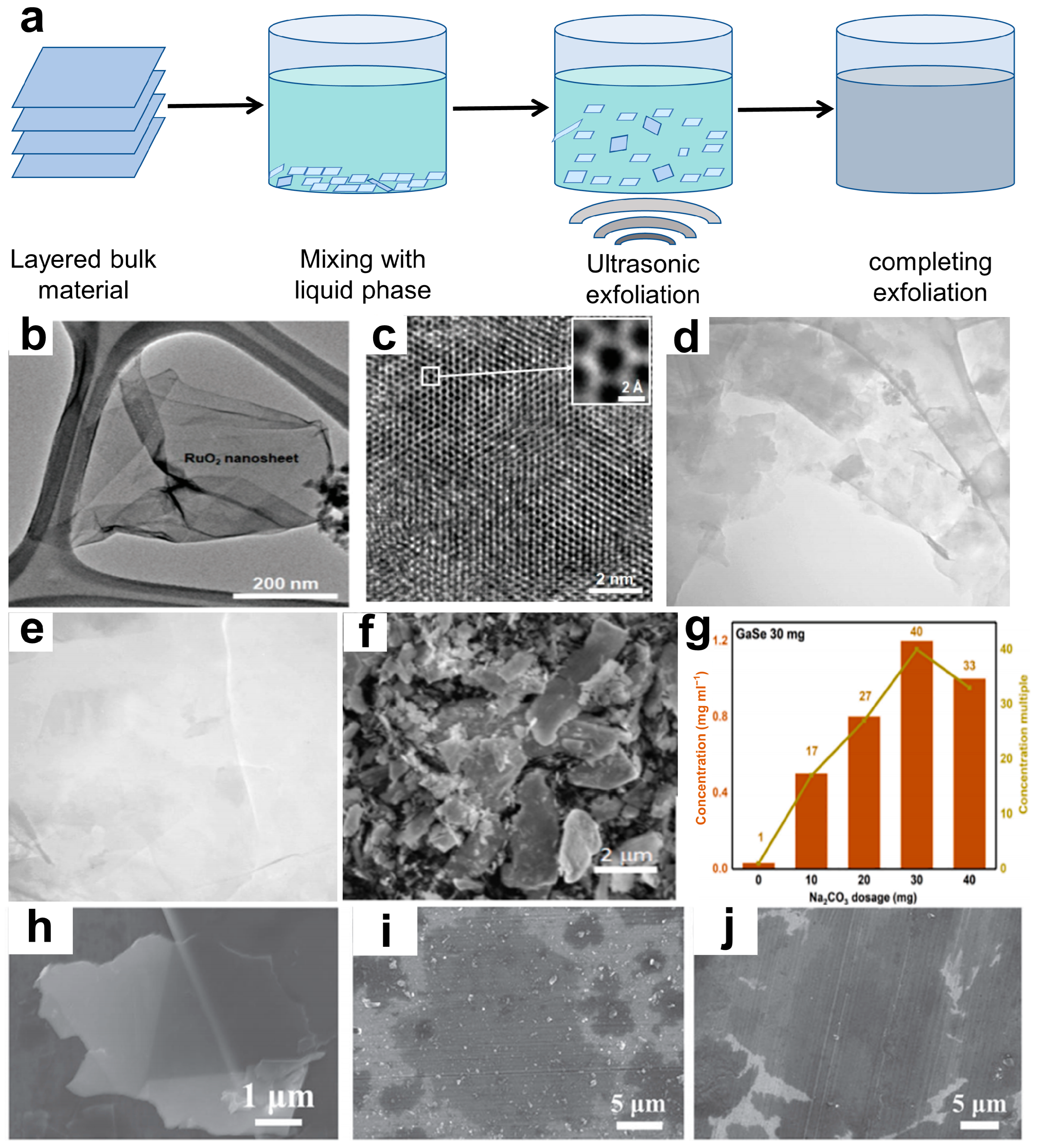
3.1.3. Ion Intercalation-Assisted Exfoliation
3.2. Bottom-Up Method
3.2.1. Vapor Deposition
- (1)
- Chemical vapor deposition
- (2)
- Physical vapor deposition
3.2.2. Hydrothermal Strategy
3.2.3. Atomic Layer Deposition
4. Application of 2D NMs
4.1. Sensor
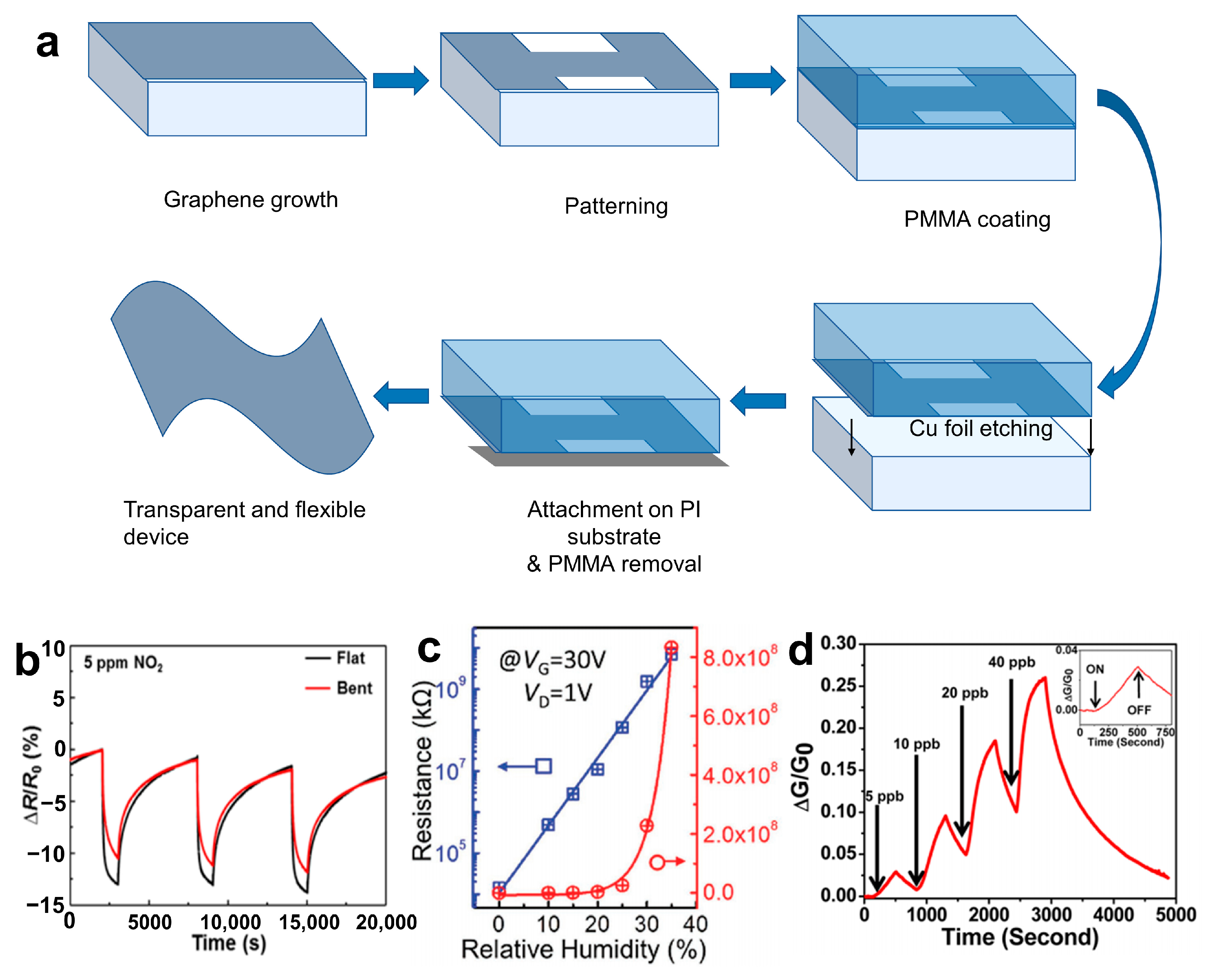
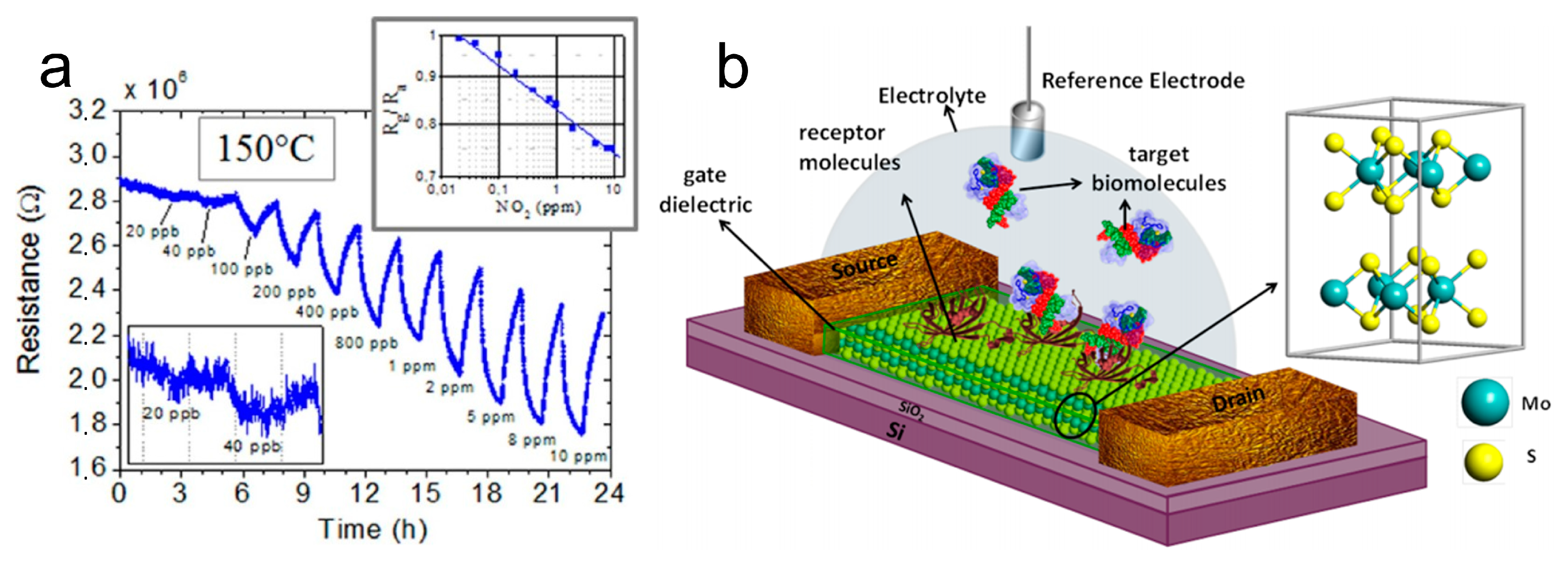
4.2. Lithium-Ion Battery
4.3. Photodetector

4.4. Electromagnetic Wave Absorption
4.5. Photocatalysis
4.6. Electrocatalysis
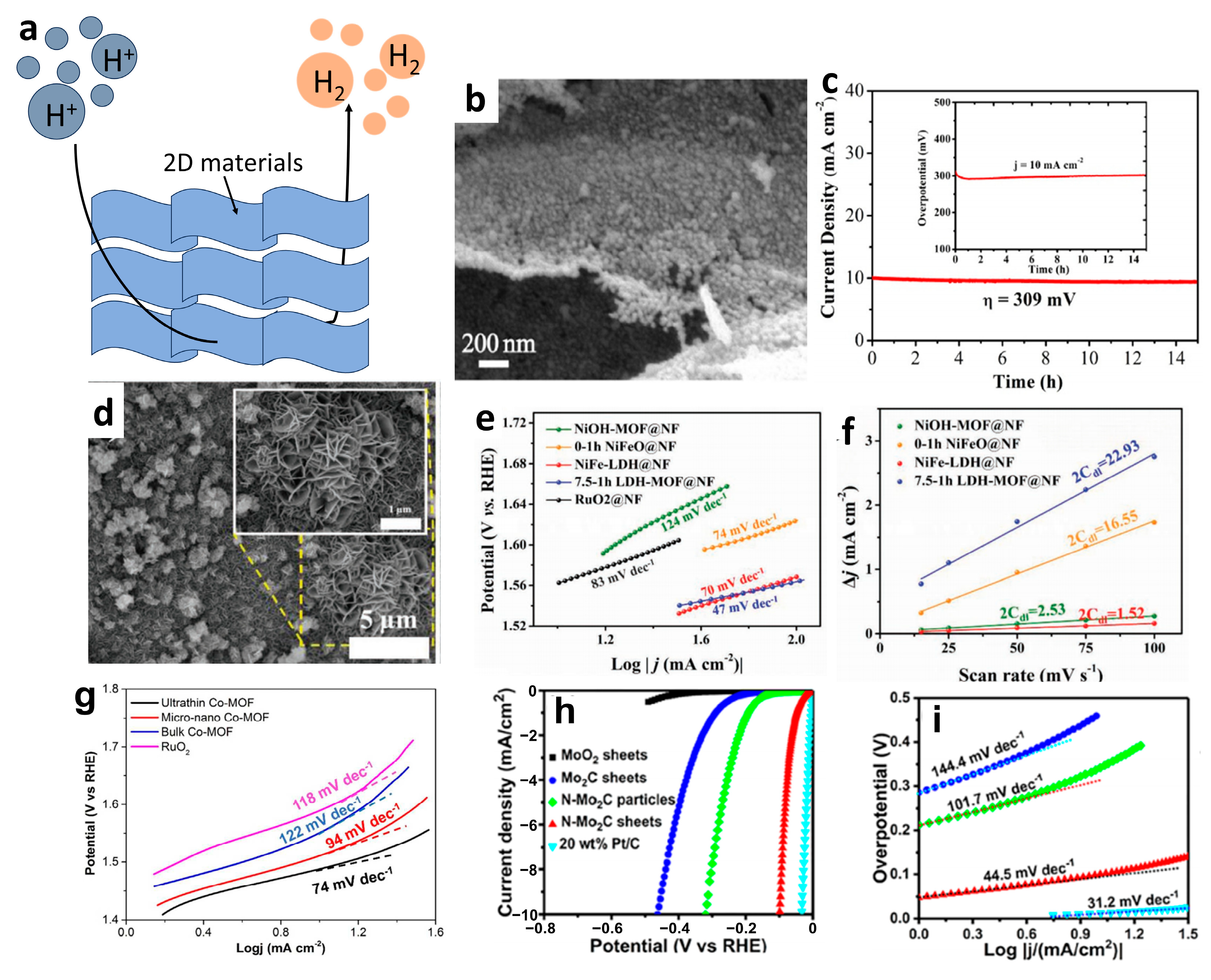
5. Summary
5.1. Preparation
5.2. Application
6. Prospect
Author Contributions
Funding
Institutional Review Board Statement
Informed Consent Statement
Data Availability Statement
Conflicts of Interest
References
- Novoselov, K.S.; Geim, A.K.; Morozov, S.V.; Jiang, D.; Zhang, Y.; Dubonos, S.V.; Grigorieva, I.V.; Firsov, A.A. Electric field effect in atomically thin carbon films. Science 2004, 306, 666–669. [Google Scholar] [CrossRef]
- Nie, X.; Wu, X.; Wang, Y.; Ban, S.; Lei, Z.; Yi, J.; Liu, Y.; Liu, Y. Surface acoustic wave induced phenomena in two-dimensional materials. Nanoscale Horiz. 2023, 8, 158–175. [Google Scholar]
- Han, J.; Yue, X.; Shan, Y.; Chen, J.; Ekoya, B.G.; Hu, L.; Liu, R.; Qiu, Z.; Cong, C. The effect of the pre-strain process on the strain engineering of two-dimensional materials and their van der Waals heterostructures. Nanomaterials 2023, 13, 833. [Google Scholar] [CrossRef]
- Zhu, Y.; Cao, X.; Tan, Y.; Wang, Y.; Hu, J.; Li, B.; Chen, Z. Single-layer MoS2: A two-dimensional material with negative poisson’s ratio. Coatings 2023, 13, 283. [Google Scholar] [CrossRef]
- Xin, G.; Yao, Z.; Zhang, B.; Song, J.; Zhang, J.; Wang, Y.; Zang, J. Simultaneous electrochemical preparation and reduction of graphene with low oxygen content and its electrochemical properties for high-performance supercapacitors. J. Mater. Sci. Mater. Electron. 2020, 31, 14128–14136. [Google Scholar] [CrossRef]
- Kumbhakar, P.; Jayan, J.; Sreedevi Madhavikutty, A.; Sreeram, P.; Saritha, A.; Ito, T.; Tiwary, C. Prospective applications of two-dimensional materials beyond laboratory frontiers: A review. IScience 2023, 26, 106671. [Google Scholar] [PubMed]
- Lim, S.; Suk, J. Flexible temperature sensors based on two-dimensional materials for wearable devices. J. Phys. D 2023, 56, 63001. [Google Scholar]
- Shahabi, M.; Raissi, H.; Zaboli, A.; Yaghoobi, R. Assessment of two-dimensional materials on the biological membrane permeability of epirubicin anti-cancer drug. Appl. Surf. Sci. 2023, 610, 155557. [Google Scholar] [CrossRef]
- Omprakash, P.; Viswesh, P.; Bhat, P.D. Review-a review of 2D perovskites and carbon-based nanomaterials for applications in solar cells and photodetectors. ECS J. Solid State Sci. Technol. 2021, 10, 31009. [Google Scholar]
- Liu, S.; Liu, G.; Chen, G.; Liu, G.; Jin, W. Scale-up fabrication of two-dimensional material membranes: Challenges and opportunities. Curr. Opin. Chem. Eng. 2023, 39, 100892. [Google Scholar] [CrossRef]
- Tripathi, M.; Lee, F.; Michail, A.; Anestopoulos, D.; McHugh, J.G.; Ogilvie, S.P.; Large, M.J.; Graf, A.A.; Lynch, P.J.; Parthenios, J. Structural defects modulate electronic and nanomechanical properties of 2D materials. ACS Nano 2021, 15, 2520–2531. [Google Scholar] [CrossRef]
- Ma, Q.; Ren, G.; Xu, K.; Ou, J. Tunable optical properties of 2D materials and their applications. Adv. Opt. Mater. 2021, 9, 2001313. [Google Scholar] [CrossRef]
- Xie, J.; Liao, L.; Gong, Y.; Li, Y.; Shi, F.; Pei, A.; Cui, Y. Stitching h-BN by atomic layer deposition of LiF as a stable interface for lithium metal anode. Sci. Adv. 2017, 3, 3170. [Google Scholar] [CrossRef]
- Pi, L.; Li, L.; Liu, K.; Zhang, Q.; Li, H.; Zhai, T. Recent progress on 2D noble-transition-metal dichalcogenides. Adv. Energy Mater. 2019, 29, 1904932. [Google Scholar] [CrossRef]
- Si, J.; Yu, J.; Shen, Y.; Zeng, M.; Fu, L. Elemental 2D materials: Progress and perspectives toward unconventional structures. Small Struct. 2021, 2, 2000101. [Google Scholar] [CrossRef]
- Chen, C.; Tao, L.; Du, S.; Chen, W.; Wang, Y.; Zou, Y.; Wang, S. Advanced exfoliation strategies for layered double hydroxides and applications in energy conversion and storage. Adv. Energy Mater. 2020, 30, 1909832. [Google Scholar] [CrossRef]
- Wang, Y.; Liu, L.; Ma, T.; Zhang, Y.; Huang, H. 2D graphitic carbon nitride for energy conversion and storage. Adv. Funct. Mater. 2021, 31, 2102540.2. [Google Scholar] [CrossRef]
- Naguib, M.; Mochalin, V.; Barsoum, M.; Gogotsi, Y. 25th anniversary article: MXenes: A new family of two-dimensional materials. Adv. Mater. 2014, 26, 992. [Google Scholar] [CrossRef]
- Tian, P. Properties and applications of transition metal carbide two-dimensional materials. J. Phys. Conf. Ser. 2022, 2393, 012027. [Google Scholar] [CrossRef]
- Zhao, L.; Wang, B.; Wang, R. A critical review on new and efficient 2D materials for catalysis. Adv. Mater. Interfaces 2022, 29, 2200771. [Google Scholar] [CrossRef]
- Marian, M.; Berman, D.; Nečas, D.; Emami, N.; Ruggiero, A.; Rosenkranz, A. Roadmap for 2D materials in biotribological/biomedical applications—A review. Adv. Colloid Interface Sci. 2022, 307, 102747. [Google Scholar] [CrossRef]
- He, F.; Zhou, Y.; Ye, Z.; Cho, S.; Jeong, J.; Meng, X.; Wang, Y. Moiré Patterns in 2D Materials: A Review. ACS Nano 2021, 15, 5944–5958. [Google Scholar] [CrossRef]
- Zheng, J.; Wu, Y.; Sun, Y.; Rong, J.; Li, H.; Niu, L. Advanced anode materials of potassium ion batteries: From zero dimension to three dimensions. Nano-Micro Lett. 2021, 13, 12. [Google Scholar] [CrossRef]
- Manu, B.; Gupta, A.; Jayatissa, A. Tribological properties of 2D materials and composites-A review of recent advances. Materials 2021, 14, 1630. [Google Scholar] [CrossRef]
- Mathew, R.; Lee, C.; Tseng, C.; Chand, P.; Huang, Y.; Chen, H.; Chen, Y. Stoichiometry-controlled MoxW1−xTe2 nanowhiskers: A novel electrocatalyst for Pt-free dye-sensitized solar cells. ACS Appl. Mater. Interfaces 2020, 12, 34815–34824. [Google Scholar] [CrossRef] [PubMed]
- Liu, Y.; Li, R. Study on ultrasound-assisted liquid-phase exfoliation for preparing graphene-like molybdenum disulfide nanosheets. Ultrason. Sonochem. 2020, 63, 104923. [Google Scholar] [CrossRef]
- Qin, T.; Wang, Z.; Wang, Y.; Besenbacher, F.; Otyepka, M.; Dong, M. Recent progress in emerging two-dimensional transition metal carbides. Nanomicro Lett. 2021, 13, 183. [Google Scholar] [CrossRef] [PubMed]
- Panda, P.; Grigoriev, A.; Mishra, Y.; Ahuja, R. Progress in supercapacitors: Roles of two dimensional nanotubular materials. Nanoscale Adv. 2020, 2, 70–108. [Google Scholar] [CrossRef] [PubMed]
- Jena, N.; Araujo, R.; Shukla, V.; Ahuja, R. Borophane as a benchmate of graphene: A potential 2D material for anode of Li and Na-ion batteries. ACS Appl. Mater. Interfaces 2017, 9, 16148–16158. [Google Scholar] [CrossRef] [PubMed]
- Cai, X.; Luo, Y.; Liu, B.; Cheng, H. Preparation of 2D material dispersions and their applications. Chem. Soc. Rev. 2018, 47, 6224–6266. [Google Scholar] [CrossRef]
- Kumar, P.; Abuhimd, H.; Wahyudi, W.; Li, M.; Ming, J.; Li, L. Review-two-dimensional layered materials for energy storage applications. ECS J. Solid State Sci. Technol. 2016, 5, Q3021–Q3025. [Google Scholar] [CrossRef]
- Goggin, D.; Samaniuk, J. 2D colloids: Size- and shape-controlled 2D materials at fluid–fluid interfaces. Langmuir 2021, 37, 14157–14166. [Google Scholar] [CrossRef] [PubMed]
- Zhang, X.; Zhang, Z.; Zhang, S.; Li, D.; Ma, W.; Ma, C.; Xing, B. 2D materials: Size effect on the cytotoxicity of layered black phosphorus and underlying mechanisms. Small 2017, 13, 1701210. [Google Scholar] [CrossRef] [PubMed]
- Ding, B.; Pan, Y.; Zhang, Z.; Lan, T.; Huang, Z.; Lu, B.; Cheng, H. Largely tunable magneto-coloration of monolayer 2D materials via size tailoring. ACS Nano 2021, 15, 9445–9452. [Google Scholar] [CrossRef]
- Lee, W.; Park, Y. Tuning electrical properties of 2D materials by self-assembled monolayers. Adv. Mater. Interfaces 2018, 5, 1700316. [Google Scholar] [CrossRef]
- Zhang, G.; Chaves, A.; Huang, S.; Wang, F.; Xing, Q.; Low, T.; Yan, H. Determination of layer-dependent exciton binding energies in few-layer black phosphorus. Sci. Adv. 2018, 4, 9977. [Google Scholar] [CrossRef]
- Akinwande, D.; Brennan, C.; Bunch, J.; Egberts, P.; Felts, J.; Gao, H.; Zhu, Y. A review on mechanics and mechanical properties of 2D materials-graphene and beyond. Extrem. Mech. Lett. 2017, 13, 42–77. [Google Scholar] [CrossRef]
- Vargas-Bernal, R. Electrical properties of two-dimensional materials used in gas sensors. Sensors 2019, 19, 1295. [Google Scholar] [CrossRef]
- Yong, C.-K.; Horng, J.; Shen, Y.; Cai, H.; Wang, A.; Yang, C.-S.; Lin, C.-K.; Zhao, S.; Watanabe, K.; Taniguchi, T.; et al. Biexcitonic optical Stark effects in monolayer molybdenum diselenide. Nat. Phys. 2018, 14, 1092. [Google Scholar] [CrossRef]
- Zulkifli, N.; Said, S.; Taib, M.; Arifin, K.; Mahmood, S.; Woon, K.; Zakaria, R. Photocatalytic application of two-dimensional materials-based heterostructure based on molybdenum and tungsten disulfides and gallium nitride: A density-functional theory study. Mater. Today Commun. 2020, 25, 101646. [Google Scholar] [CrossRef]
- Hao, S.; Zhao, X.; Cheng, Q.; Xing, Y.; Ma, W.; Wang, X.; Xu, X. A mini review of the preparation and photocatalytic properties of two-dimensional materials. Front. Chem. 2020, 8, 582146. [Google Scholar] [CrossRef]
- Sharma, A.; Rangra, V.; Thakur, A. Synthesis, properties, and applications of MBenes (two-dimensional metal borides) as emerging 2D materials: A review. J. Mater. Sci. 2022, 57, 12738–12751. [Google Scholar] [CrossRef]
- Huang, G.; Jiang, P.; Zhang, X.; Zhou, C.; Zhou, J.; Huang, Y.; Yang, P.; Yang, L.; Tian, X.; Hao, Y. Efficient preparation and characterization of graphene based on ball milling. Diam. Relat. Mater. 2022, 130, 109438. [Google Scholar] [CrossRef]
- An, L.; Yu, Y.; Bai, C.; Bai, Y.; Zhang, B.; Gao, K.; Wang, X.; Lai, Z.; Zhang, J. Exfoliation of 2D van der Waals crystal in ultra-high vacuum for interface engineering. Sci. Bull. 2022, 67, 1345–1351. [Google Scholar]
- An, L.; Yu, Y.; Bai, C.; Bai, Y.; Zhang, B.; Gao, K.; Zhang, J. Simultaneous production and functionalization of hexagonal boron nitride nanosheets by solvent-free mechanical exfoliation for superlubricant water-based lubricant additives. NPJ 2D Mater. Appl. 2019, 3, 28. [Google Scholar] [CrossRef]
- Deng, S.; Che, S.; Debbarma, R.; Berry, V. Strain in a single wrinkle on an MoS2 flake for in-plane realignment of band structure for enhanced photo-response. Nanoscale 2019, 11, 504–511. [Google Scholar] [CrossRef] [PubMed]
- Tyurnina, A.; Morton, J.; Kaur, A.; Mi, J.; Grobert, N.; Porfyrakis, K.; Eskin, D. Effects of green solvents and surfactants on the characteristics of few-layer graphene produced by dual-frequency ultrasonic liquid phase exfoliation technique. Carbon 2023, 206, 7–15. [Google Scholar] [CrossRef]
- Lin, Z.; Wang, C.; Chai, Y. Emerging group-VI elemental 2D materials: Preparations, properties, and device applications. Small 2020, 16, 2003319. [Google Scholar] [CrossRef]
- Xie, L.; Li, H.; Yang, Z.; Zhao, X.; Zhang, H.; Zhang, P.; Cao, Z.; He, J.; Pan, P.; Liu, J.; et al. Facile large-scaled fabrication of graphene-like materials by ultrasonic assisted shear exfoliation method for enhanced performance on flexible supercapacitor applications. Appl. Nanosci. 2020, 10, 1131–1139. [Google Scholar] [CrossRef]
- Kim, S.; Kim, S.; Kim, M.; Kim, J.; Mizusaki, S.; Ko, D.; Shin, W. Ultrasonic assisted exfoliation for efficient production of RuO2 monolayer nanosheets. Inorg. Chem. Front. 2021, 8, 4482–4487. [Google Scholar] [CrossRef]
- Mushfiq, S.; Afzalzadeh, R. Verification of experimental results with simulation on production of few-layer graphene by liquid-phase exfoliation utilizing sonication. Sci. Rep. 2022, 12, 9872. [Google Scholar] [CrossRef]
- Qi, X.; Ding, C.; Gao, M.; Wang, F.; Hui, Y.; Yao, Y.; Qu, R.; Guo, Y.; Zhang, Z.; Zhao, W.; et al. High-efficient production of mono- to few-layer gase nanosheets via a novel Na2Co3-promoted ultrasonic exfoliation method. Mater. Lett. 2021, 305, 130747. [Google Scholar] [CrossRef]
- Shi, D.; Yang, M.; Chang, B.; Ai, Z.; Zhang, K.; Shao, Y.; Wang, S.; Wu, Y.; Hao, X. Ultrasonic-ball milling: A novel strategy to prepare large-size ultrathin 2D materials. Small 2020, 16, 1906734. [Google Scholar] [CrossRef] [PubMed]
- Takahashi, Y.; Kobayashi, Y.; Wang, Z.; Ito, Y.; Ota, M.; Ida, H.; Kumatani, A.; Miyazawa, K.; Fujita, T.; Shiku, H.; et al. High-resolution electrochemical mapping of the hydrogen evolution reaction on transition-metal dichalcogenide nanosheets. Angew. Chem. 2020, 59, 3601–3608. [Google Scholar] [CrossRef]
- El Garah, M.; Bertolazzi, S.; Ippolito, S.; Eredia, M.; Janica, I.; Melinte, G.; Ersen, O.; Marletta, G.; Ciesielski, A.; Samorì, P. MoS2 nanosheets via electrochemical lithium-ion intercalation under ambient conditions. FlatChem 2018, 9, 33–39. [Google Scholar] [CrossRef]
- Xu, Z.; Zhang, Y.; Liu, M.; Meng, Q.; Shen, C.; Xu, L.; Gao, C. Two-dimensional titanium carbide MXene produced by ternary cations intercalation via structural control with angstrom-level precision. IScience 2022, 5, 105562. [Google Scholar] [CrossRef]
- Tian, L.; Qiao, H.; Huang, Z.; Qi, X. Li-Ion intercalated exfoliated WS2 nanosheets with enhanced electrocatalytic hydrogen evolution performance. Cryst. Res. Technol. 2021, 56, 2000165. [Google Scholar] [CrossRef]
- Hou, X.; Zhang, W.; Peng, J.; Zhou, L.; Wu, J.; Xie, K.; Fang, Z. Phase transformation of 1T′-MoS2 induced by electrochemical prelithiation for lithium-ion storage. ACS Appl. Energy Mater. 2022, 5, 11292–11303. [Google Scholar] [CrossRef]
- Peng, R.; Ma, Y.; Wu, Q.; Huang, B.; Dai, Y. Two-dimensional materials with intrinsic auxeticity: Progress and perspectives. Nanoscale 2019, 11, 11413–11428. [Google Scholar] [CrossRef]
- Yi, K.; Liu, D.; Chen, X.; Yang, J.; Wei, D.; Liu, Y.; Wei, D. Plasma-enhanced chemical vapor deposition of two-dimensional materials for applications. Acc. Chem. Res. 2021, 54, 1011–1022. [Google Scholar] [CrossRef]
- Chen, L.; Yang, C.; Yan, C. High-performance UV detectors based on 2D CVD bismuth oxybromide single-crystal nanosheets. J. Mater. Sci. Technol. 2020, 48, 100–104. [Google Scholar] [CrossRef]
- Zhang, Z.; Xu, X.; Song, J.; Gao, Q.; Li, S.; Hu, Q.; Li, X.; Wu, Y. High-performance transistors based on monolayer CVD MoS2 grown on molten glass. Appl. Phys. Lett. 2018, 113, 202103. [Google Scholar] [CrossRef]
- Chen, Z.; Xie, C.; Wang, W.; Zhao, J.; Liu, B.; Shan, J.; Wang, X.; Hong, M.; Lin, L.; Huang, L.; et al. Direct growth of wafer-scale highly oriented graphene on sapphire. Sci. Adv. 2021, 7, 0115. [Google Scholar] [CrossRef] [PubMed]
- Li, J.; Chen, M.; Zhang, C.; Dong, H.; Lin, W.; Zhuang, P.; Zhang, X. Fractal-theory-based control of the shape and quality of CVD-grown 2D materials. Adv. Mater. 2019, 31, 1902431. [Google Scholar] [CrossRef]
- Tang, L.; Tang, B.; Zhang, H.; Yuan, Y. Review—Review of research on ALGaN MOCVD growth. ECS J. Solid State Sci. Technol. 2020, 9, 24009. [Google Scholar] [CrossRef]
- Noh, G.; Song, H.; Choi, H.; Kim, M.; Jeong, J.; Lee, Y.; Kang, K. Large memory window of van der Waals heterostructure devices based on MOCVD-grown 2D layered Ge4Se9. Adv. Mater. 2022, 34, 2204982. [Google Scholar] [CrossRef] [PubMed]
- Li, Y.; Cain, J.; Hanson, E.; Murthy, A.; Hao, S.; Shi, F.; Dravid, V. Au@MoS2 core-shell heterostructures with strong light-matter interactions. Nano Lett. 2016, 16, 7696–7702. [Google Scholar] [CrossRef]
- Muratore, C.; Voevodin, A.; Glavin, N. Physical vapor deposition of 2D van der Waals materials: A review. Thin Solid Film. 2019, 688, 137500. [Google Scholar] [CrossRef]
- Anbalagan, A.K.; Hu, F.-C.; Chan, W.K.; Gandhi, A.C.; Gupta, S.; Chaudhary, M.; Chuang, K.-W.; Ramesh, A.K.; Billo, T.; Sabbah, A.; et al. Gamma-ray irradiation induced ultrahigh room-temperature ferromagnetism in MoS2 sputtered few-layered thin films. ACS Nano 2023, 17, 6555–6564. [Google Scholar] [CrossRef]
- Mannix, A.J. Synthesis of borophenes: Anisotropic, two-dimensional boron polymorphs. Science 2015, 350, 1513–1516. [Google Scholar] [CrossRef]
- Zhang, X.; Zhang, Y.; Yu, B.-B.; Yin, X.-L.; Jiang, W.-J.; Jiang, Y.; Hu, J.-S.; Wan, L.-J. Physical vapor deposition of amorphous MoS2 nanosheet arrays on carbon cloth for highly reproducible large-area electrocatalysts for the hydrogen evolution reaction. J. Mater. Chem. A 2015, 3, 19277–19281. [Google Scholar] [CrossRef]
- Zhu, F.-F.; Chen, W.-J.; Xu, Y.; Gao, C.-L.; Guan, D.-D.; Liu, C.-H.; Qian, D.; Zhang, S.-C.; Jia, J.-F. Epitaxial growth of two-dimensional stanene. Nat. Mater. 2015, 14, 1020–1025. [Google Scholar] [CrossRef] [PubMed]
- Ji, J.; Song, X.; Liu, J.; Yan, Z.; Huo, C.; Zhang, S.; Su, M.; Liao, L.; Wang, W.; Ni, Z.; et al. Two-dimensional antimonene single crystals grown by van der Waals epitaxy. Nat. Commun. 2016, 7, 13352. [Google Scholar] [CrossRef] [PubMed]
- Liu, Z.; Wei, W.; Xu, K.; Wu, H.; Su, T.; Zhu, Y.; Wang, Z. Preparation and electrochromic properties of vanadium oxide two-dimensional materials. Mater. Res. Express 2019, 6, 1150. [Google Scholar] [CrossRef]
- Pradhan, I.; Bandyopadhyay, A.; Nayak, A.; Kumar, P. Freestanding silver-doped zinc oxide 2D crystals synthesized by a surface energy-controlled hydrothermal strategy. ACS Appl. Nano Mater. 2021, 4, 10534–10544. [Google Scholar] [CrossRef]
- Huang, B.; Liu, Y.; Xie, Z. Biomass derived 2D carbons via a hydrothermal carbonization method as efficient bifunctional ORR/HER electrocatalysts. J. Mater. Chem. A 2017, 5, 23481–23488. [Google Scholar] [CrossRef]
- Long, L.; Quang, N.; Khuong, T.; Kien, P.; Thang, N.; Van Khai, T. Controllable synthesis by hydrothermal method and optical properties of 2D MoS2/rGO nanocomposites. J. Solgel. Sci. Technol. 2023, 106, 699–714. [Google Scholar] [CrossRef]
- Vidhya, M.; Selvakumari, T.; Marnadu, R.; Ashraf, I.; Shkir, M. Impact of temperature on the properties of MoS2 nanoflakes synthesized by facile hydrothermal method for electrochemical supercapacitor applications. Inorg. Chem. Commun. 2022, 145, 109928. [Google Scholar] [CrossRef]
- Schiliro, E.; Lo Nigro, R.; Roccaforte, F.; Giannazzo, F. Substrate-driven atomic layer deposition of high-kappa dielectrics on 2D materials. Appl. Sci. 2021, 11, 11052. [Google Scholar] [CrossRef]
- Martella, C.; Melloni, P.; Cinquanta, E.; Cianci, E.; Alia, M.; Longo, M.; Lamperti, A.; Vangelista, S.; Fanciulli, M.; Molle, A. Engineering the growth of MoS2 via atomic layer deposition of molybdenum oxide film precursor. Adv. Electron. Mater. 2016, 2, 1600330. [Google Scholar] [CrossRef]
- Tan, C.; Cao, X.; Wu, X.-J.; He, Q.; Yang, J.; Zhang, X.; Chen, J.; Zhao, W.; Han, S.; Nam, G.-H.; et al. Recent advances in ultrathin two-dimensional nanomaterials. Chem. Rev. 2017, 117, 6225–6331. [Google Scholar] [CrossRef]
- Glavin, N.R.; Rao, R.; Varshney, V.; Bianco, E.; Apte, A.; Roy, A.; Ringe, E.; Ajayan, P.M. 2D materials: Emerging applications of elemental 2D materials. Adv. Mater. 2020, 32, 2070052. [Google Scholar] [CrossRef]
- Varghese, S.; Varghese, S.; Swaminathan, S.; Singh, K.; Mittal, V. Two-dimensional materials for sensing: Graphene and beyond. Electronics 2015, 4, 651–687. [Google Scholar] [CrossRef]
- Kim, Y.; Kim, S.; Kim, Y.; Shim, Y.; Kim, S.; Hong, B.; Jang, H. Self-activated transparent all-graphene gas sensor with endurance to humidity and mechanical bending. ACS Nano 2015, 9, 10453–10460. [Google Scholar] [CrossRef] [PubMed]
- Prezioso, S.; Perrozzi, F.; Giancaterini, L.; Cantalini, C.; Treossi, E.; Palermo, V.; Nardone, M.; Santucci, S.; Ottaviano, L. Graphene oxide as a practical solution to high sensitivity gas sensing. J. Phys. Chem. C 2013, 117, 10683–10690. [Google Scholar] [CrossRef]
- Wang, X.; Gu, D.; Li, X.; Lin, S.; Zhao, S.; Rumyantseva, M.; Gaskov, A. Reduced graphene oxide hybridized with WS2 nanoflakes based heterojunctions for selective ammonia sensors at room temperature. Sens. Actuators B Chem. 2019, 282, 290–299. [Google Scholar] [CrossRef]
- Zhao, J.; Li, N.; Yu, H.; Wei, Z.; Liao, M.; Chen, P.; Zhang, G. Highly sensitive MoS2 humidity sensors array for noncontact sensation. Adv. Mater. 2017, 29, 1702076. [Google Scholar] [CrossRef] [PubMed]
- Abbas, A.N.; Liu, B.; Chen, L.; Ma, Y.; Cong, S.; Aroonyadet, N.; Köpf, M.; Nilges, T.; Zhou, C. Black phosphorus gas sensors. ACS Nano 2015, 9, 5618–5624. [Google Scholar] [CrossRef]
- Zhou, Y.; Gao, C.; Guo, Y. UV assisted ultrasensitive trace NO2 gas sensing based on few-layer MoS2 nanosheet–ZnO nanowire heterojunctions at room temperature. J. Mater. Chem. A 2018, 6, 10286–10296. [Google Scholar] [CrossRef]
- Yadav, V.; Roy, S.; Singh, P.; Khan, Z.; Jaiswal, A. 2D MoS2-based nanomaterials for therapeutic, bioimaging, and biosensing applications. Small 2019, 15, 1803706. [Google Scholar] [CrossRef]
- Chen, S.; Liu, S.; Wang, P.; Liu, H.; Liu, L. Highly stretchable fiber-shaped e-textiles for strain/pressure sensing, full-range human motions detection, health monitoring, and 2D force mapping. J. Mater. Sci. 2018, 53, 2995–3005. [Google Scholar] [CrossRef]
- Anichini, C.; Czepa, W.; Pakulski, D.; Aliprandi, A.; Ciesielski, A.; Samorì, P. Chemical sensing with 2D materials. Chem. Soc. Rev. 2018, 47, 486–498. [Google Scholar] [CrossRef] [PubMed]
- Sarkar, D.; Liu, W.; Xie, X.; Anselmo, A.; Mitragotri, S.; Banerjee, K. MoS2 field-effect transistor for next-generation label-free biosensors. ACS Nano 2014, 8, 3992–4003. [Google Scholar] [CrossRef] [PubMed]
- Kim, C.S.; Yang, H.M.; Lee, J.; Lee, G.S.; Choi, H.; Kim, Y.J.; Lim, S.H.; Cho, S.H.; Cho, B.J. Self-powered wearable electrocardiography using a wearable thermoelectric power generator. ACS Energy Lett. 2018, 3, 501–507. [Google Scholar] [CrossRef]
- Nisha, A.; Maheswari, P.; Anbarasan, P.; Rajesh, K.; Jaroszewicz, Z. Sensitivity enhancement of surface plasmon resonance sensor with 2D material covered noble and magnetic material (Ni). Opt. Quantum Electron. 2019, 51, 19. [Google Scholar] [CrossRef]
- Hassel, J.; Oksanen, M.; Elo, T.; Seppä, H.; Hakonen, P. Terahertz detection using mechanical resonators based on 2D materials. AIP Adv. 2017, 7, 650140–650146. [Google Scholar] [CrossRef]
- Zhang, C.; Ma, Y.; Zhang, X.; Abdolhosseinzadeh, S.; Sheng, H.; Lan, W.; Nüesch, F. Two-dimensional transition metal carbides and nitrides (MXenes): Synthesis, properties, and electrochemical energy storage applications. Energy Environ. Mater. 2020, 3, 29–55. [Google Scholar] [CrossRef]
- Yu, T.; Yang, H.; Cheng, H.; Li, F. Theoretical progress of 2D six-membered-ring inorganic materials as anodes for non-Lithium-ion batteries. Small 2022, 18, 2270231. [Google Scholar] [CrossRef]
- Syamsai, R.; Rodriguez, J.R.; Pol, V.G.; Van Le, Q.; Batoo, K.M.; Farooq, S.A.; Pandiaraj, S.; Muthumareeswaran, M.R.; Raslan, E.H.; Grace, A.N. Double transition metal MXene (TixTa4−xC3) 2D materials as anodes for Li-ion batteries. Sci. Rep. 2021, 11, 688. [Google Scholar] [CrossRef]
- Tian, Y.; An, Y.; Xiong, S.; Feng, J.; Qian, Y. A general method for constructing robust, flexible and freestanding MXene@metal anodes for high-performance potassium-ion batteries. J. Mater. Chem. A 2019, 7, 9716–9725. [Google Scholar] [CrossRef]
- Kędzierski, T.; Wenelska, K.; Bęben, D.; Zielińska, B.; Mijowska, E. Ultrafast self-expanded reduced graphene oxide and 2D MoS2 based films as anode in Li-ion battery. Electrochim. Acta 2022, 434, 141318. [Google Scholar] [CrossRef]
- Huang, Y.; Yang, H.; Zhang, Y.; Zhang, Y.; Wu, Y.; Tian, M.; Liu, N. A safe and fast-charging lithium-ion battery anode using MXene supported Li3VO4. J. Mater. Chem. A 2019, 7, 11250–11256. [Google Scholar] [CrossRef]
- Cheng, Z.; Zhao, T.; Zeng, H. 2D material-based photodetectors for infrared imaging. Small Sci. 2022, 2, 2100051. [Google Scholar] [CrossRef]
- Zhang, K.; Zhang, L.; Han, L.; Wang, L.; Chen, Z.; Xing, H.; Chen, X. Recent progress and challenges based on two-dimensional material photodetectors. Nano Express 2021, 2, 12001. [Google Scholar] [CrossRef]
- Yao, J.; Yang, G. 2D material broadband photodetectors. Nanoscale 2020, 12, 454–476. [Google Scholar] [CrossRef] [PubMed]
- Yang, C.; Wang, G.; Liu, M.; Yao, F.; Li, H. Design and implementation principle of two-dimensional material photodetectors. Nanomaterials 2021, 11, 2688. [Google Scholar] [CrossRef] [PubMed]
- Polat, E.O.; Mercier, G.; Nikitskiy, I.; Puma, E.; Galan, T.; Gupta, S.; Montagut, M.; Piqueras, J.J.; Bouwens, M.; Durduran, T.; et al. Flexible graphene photodetectors for wearable fitness monitoring. Sci. Adv. 2019, 5, 7846. [Google Scholar] [CrossRef]
- Urich, A.; Unterrainer, K.; Mueller, T. Intrinsic response time of graphene photodetectors. Nano Lett. 2011, 11, 2804–2808. [Google Scholar] [CrossRef]
- Nidhi; Jakhar, A.; Uddin, W.; Kumar, J.; Nautiyal, T.; Das, S. Nanolayered black arsenic-silicon lateral heterojunction photodetector for visible to mid-infrared wavelengths. ACS Appl. Nano Mater. 2020, 3, 9401–9409. [Google Scholar] [CrossRef]
- Qiu, Q.; Huang, Z. Photodetectors of 2D materials from ultraviolet to terahertz waves. Adv. Mater. 2021, 33, 2008126. [Google Scholar] [CrossRef]
- Viti, L.; Politano, A.; Zhang, K.; Vitiello, M. Thermoelectric terahertz photodetectors based on selenium-doped black phosphorus flakes. Nanoscale 2019, 11, 1995–2002. [Google Scholar] [CrossRef] [PubMed]
- Xu, Y.; Yuan, J.; Fei, L.; Wang, X.; Bao, Q.; Wang, Y.; Zhang, K.; Zhang, Y. Selenium-doped black phosphorus for high-responsivity 2D photodetectors. Small 2016, 12, 5000–5007.2. [Google Scholar] [CrossRef] [PubMed]
- Oyedele, A.D.; Yang, S.; Liang, L.; Puretzky, A.A.; Wang, K.; Zhang, J.; Yu, P.; Pudasaini, P.R.; Ghosh, A.W.; Liu, Z.; et al. PdSe2: Pentagonal two-dimensional layers with high air stability for electronics. J. Am. Chem. Soc. 2017, 139, 14090–14097. [Google Scholar] [CrossRef] [PubMed]
- Wu, J.; Ma, H.; Zhong, C.; Wei, M.; Sun, C.; Ye, Y.; Xu, Y.; Tang, B.; Luo, Y.; Sun, B.; et al. Waveguide-integrated PdSe2 photodetector over a broad infrared wavelength range. Nano Lett. 2022, 22, 6816–6824. [Google Scholar] [CrossRef]
- Yang, M.; Luo, Z.; Gao, W. Robust deposition of sub-millimeter WSe2 drive ultrasensitive gate-tunable 2D material photodetectors. Adv. Opt. Mater. 2022, 10, 2200717. [Google Scholar] [CrossRef]
- Wu, J.; Chun, Y.; Li, S.; Zhang, T.; Wang, J.; Shrestha, P.; Chu, D. Broadband MoS2 field-effect phototransistors: Ultrasensitive visible-light photoresponse and negative infrared photoresponse. Adv. Mater. 2018, 30, 1705880. [Google Scholar] [CrossRef] [PubMed]
- Wang, F.; Li, L.; Huang, W.; Li, L.; Jin, B.; Li, H.; Zhai, T. Submillimeter 2D Bi2Se3 flakes toward high-performance infrared photodetection at optical communication wavelength. Adv. Funct. Mater. 2018, 28, 1802707. [Google Scholar] [CrossRef]
- Ding, C.; Fu, H.; Wu, T.; Li, Y.; Wu, S.; Ren, X.; Gao, Z.; Guo, K.; Xia, L.; Wen, G.; et al. Wave-transparent LAS enabling superior bandwidth electromagnetic wave absorption of a 2D pitaya carbon slice. J. Mater. Chem. A 2022, 1, 1763–17613. [Google Scholar] [CrossRef]
- Ma, H.; Zhang, X.; Yang, L.; Ma, L.; Park, C.; Gong, P.; Li, G. Electromagnetic wave absorption in graphene nanoribbon nanocomposite foam by multiscale electron dissipation of atomic defects, interfacial polarization and impedance match. Carbon 2023, 205, 159–170. [Google Scholar] [CrossRef]
- Yu, M.; Huang, Y.; Liu, X.; Zhao, X.; Fan, W.; She, K. In situ modification of MXene nanosheets with polyaniline nanorods for lightweight and broadband electromagnetic wave absorption. Carbon 2023, 208, 311–321. [Google Scholar] [CrossRef]
- Li, B.; Liu, S.; Lai, C.; Zeng, G.; Zhang, M.; Zhou, M.; Huang, D.; Qin, L.; Liu, X.; Li, Z.; et al. Unravelling the interfacial charge migration pathway at atomic level in 2D/2D interfacial Schottky heterojunction for visible-light-driven molecular oxygen activation. Appl. Catal. B 2020, 266, 118650. [Google Scholar] [CrossRef]
- Cheng, Y.; Chen, J.; Che, H.; Ao, Y.; Liu, B. Ultrafast photocatalytic degradation of nitenpyram by 2D ultrathin Bi2WO6: Mechanism, pathways and environmental factors. Rare Met. 2022, 41, 2439–2452. [Google Scholar] [CrossRef]
- Ke, P.; Zeng, D.; Cui, J.; Li, X.; Chen, Y. Improvement in structure and visible light catalytic performance of g-C3N4 fabricated at a higher temperature. Catalysts 2022, 12, 247. [Google Scholar] [CrossRef]
- Liu, H.; Cheng, D.; Chen, F.; Zhan, X. Porous lantern-like MFI zeolites composed of 2D nanosheets for highly efficient visible light-drin photocatalysis. Catal. Sci. Technol. 2020, 1, 351–359. [Google Scholar] [CrossRef]
- Zhong, R.; Zhang, Z.; Yi, H.; Zeng, L.; Tang, C.; Huang, L.; Gu, M. Covalently bonded 2D/2D O-g-C3N4/TiO2 heterojunction for enhanced visible-light photocatalytic hydrogen evolution. Appl. Catal. B 2018, 237, 1130–1138. [Google Scholar] [CrossRef]
- Yi, J.; Li, H.; Gong, Y.; She, X.; Song, Y.; Xu, Y.; Deng, J.; Yuan, S.; Xu, H.; Li, H. Phase and interlayer effect of transition metal dichalcogenide cocatalyst toward photocatalytic hydrogen evolution: The case of MoSe2. Appl. Catal. B 2019, 243, 330–336. [Google Scholar] [CrossRef]
- Zhao, Y.; Waterhouse, G.; Chen, G.; Xiong, X.; Wu, L.; Tung, C.; Zhang, T. Two-dimensional-related catalytic materials for solar-driven conversion of COx into valuable chemical feedstocks. Chem. Soc. Rev. 2019, 48, 1972–2010. [Google Scholar] [CrossRef]
- Chen, W.; Han, B.; Tian, C.; Liu, X.; Liang, S.; Deng, H.; Lin, Z. MOFs-derived ultrathin holey Co3O4 nanosheets for enhanced visible light CO2 reduction. Appl. Catal. B 2019, 244, 996–1003. [Google Scholar] [CrossRef]
- Qian, W.; Xu, S.; Zhang, X.; Li, C.; Yang, W.; Bowen, C.; Yang, Y. Differences and similarities of photocatalysis and electrocatalysis in two-dimensional nanomaterials: Strategies, traps, applications and challenges. Nanomicro Lett. 2021, 13, 156. [Google Scholar] [CrossRef]
- Zhang, Z.; Liu, P.; Song, Y.; Hou, Y.; Xu, B.; Liao, T.; Zhang, H.; Guo, J.; Sun, Z. Heterostructure engineering of 2D superlattice materials for electrocatalysis. Adv. Sci. 2022, 9, 2204297. [Google Scholar] [CrossRef]
- Hao, J.; Zhang, G.; Zheng, Y.; Luo, W.; Jin, C.; Wang, R.; Wang, Z.; Zheng, W. Controlled synthesis of Ni3C/nitrogen-doped carbon nanoflakes for efficient oxygen evolution. Electrochim. Acta 2019, 320, 134631. [Google Scholar] [CrossRef]
- Chen, J.; Zhuang, P.; Ge, Y.; Chu, H.; Yao, L.; Cao, Y.; Wang, Z.; Chee, M.O.L.; Dong, P.; Shen, J.; et al. Sublimation-vapor phase pseudomorphic transformation of template-directed MOFs for efficient oxygen evolution reaction. Adv. Funct. Mater. 2019, 29, 1903875. [Google Scholar] [CrossRef]
- Ge, K.; Sun, S.; Zhao, Y.; Yang, K.; Wang, S.; Zhang, Z.; Cao, J.; Yang, Y.; Zhang, Y.; Pan, M.; et al. Facile synthesis of two-dimensional iron/cobalt metal-organic framework for efficient oxygen evolution electrocatalysis. Angew. Chem. Int. Ed. 2021, 60, 12097–12102. [Google Scholar] [CrossRef] [PubMed]
- Xu, Y.; Li, B.; Zheng, S.; Wu, P.; Zhan, J.; Xue, H.; Pang, H. Ultrathin two-dimensional cobalt-organic framework nanosheets for high-performance electrocatalytic oxygen evolution. J. Mater. Chem. A 2018, 6, 22070–22076. [Google Scholar] [CrossRef]
- Jia, J.; Xiong, T.; Zhao, L.; Wang, F.; Liu, H.; Hu, R.; Zhou, J.; Zhou, W.; Chen, S. Ultrathin n-doped Mo2C nanosheets with exposed active sites as efficient electrocatalyst for hydrogen evolution reactions. ACS Nano 2017, 11, 12509–12518. [Google Scholar] [CrossRef] [PubMed]
- Zang, X.; Chen, W.; Zou, X.; Hohman, J.; Yang, L.; Li, B.; Lin, L. Hydrogen electrocatalysis: Self-assembly of large-area 2D polycrystalline transition metal carbides for hydrogen electrocatalysis. Adv. Mater. 2018, 30, 1870385. [Google Scholar] [CrossRef]
- Xu, K.; Chen, P.; Li, X.; Tong, Y.; Ding, H.; Wu, X.; Chu, W.; Peng, Z.; Wu, C.; Xie, Y. Metallic nickel nitride nanosheets realizing enhanced electrochemical water oxidation. J. Am. Chem. Soc. 2015, 137, 4119–4125. [Google Scholar] [CrossRef]
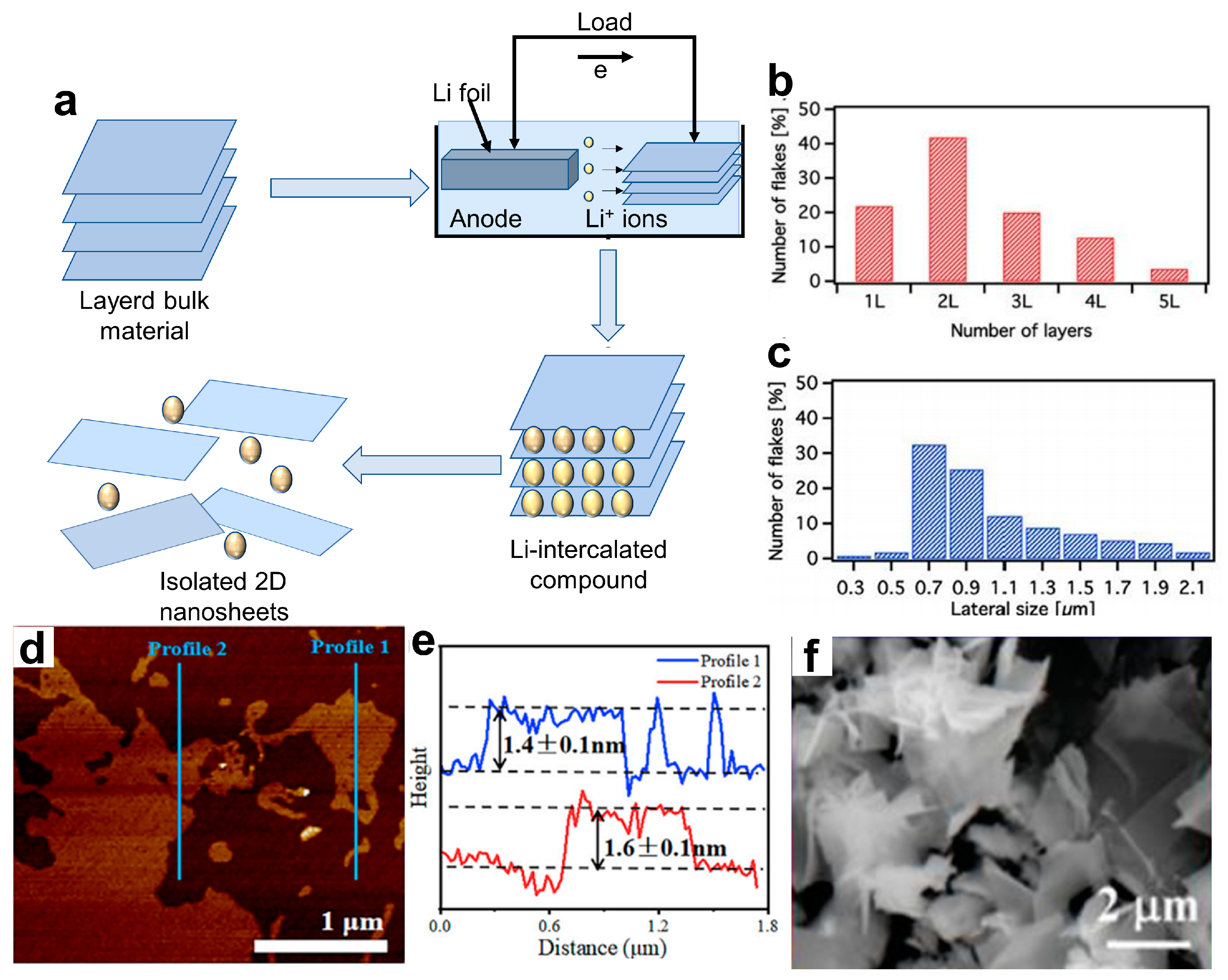
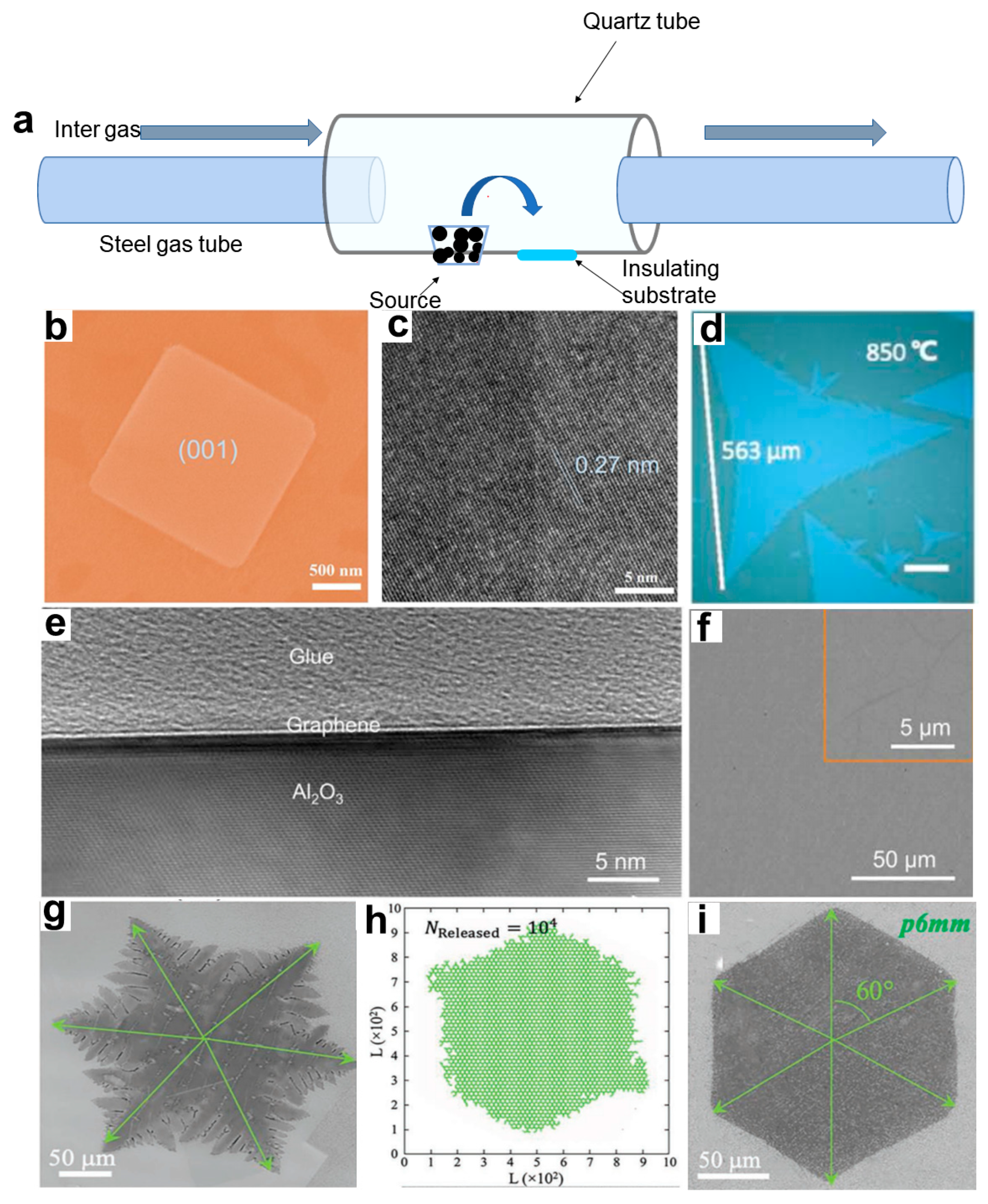
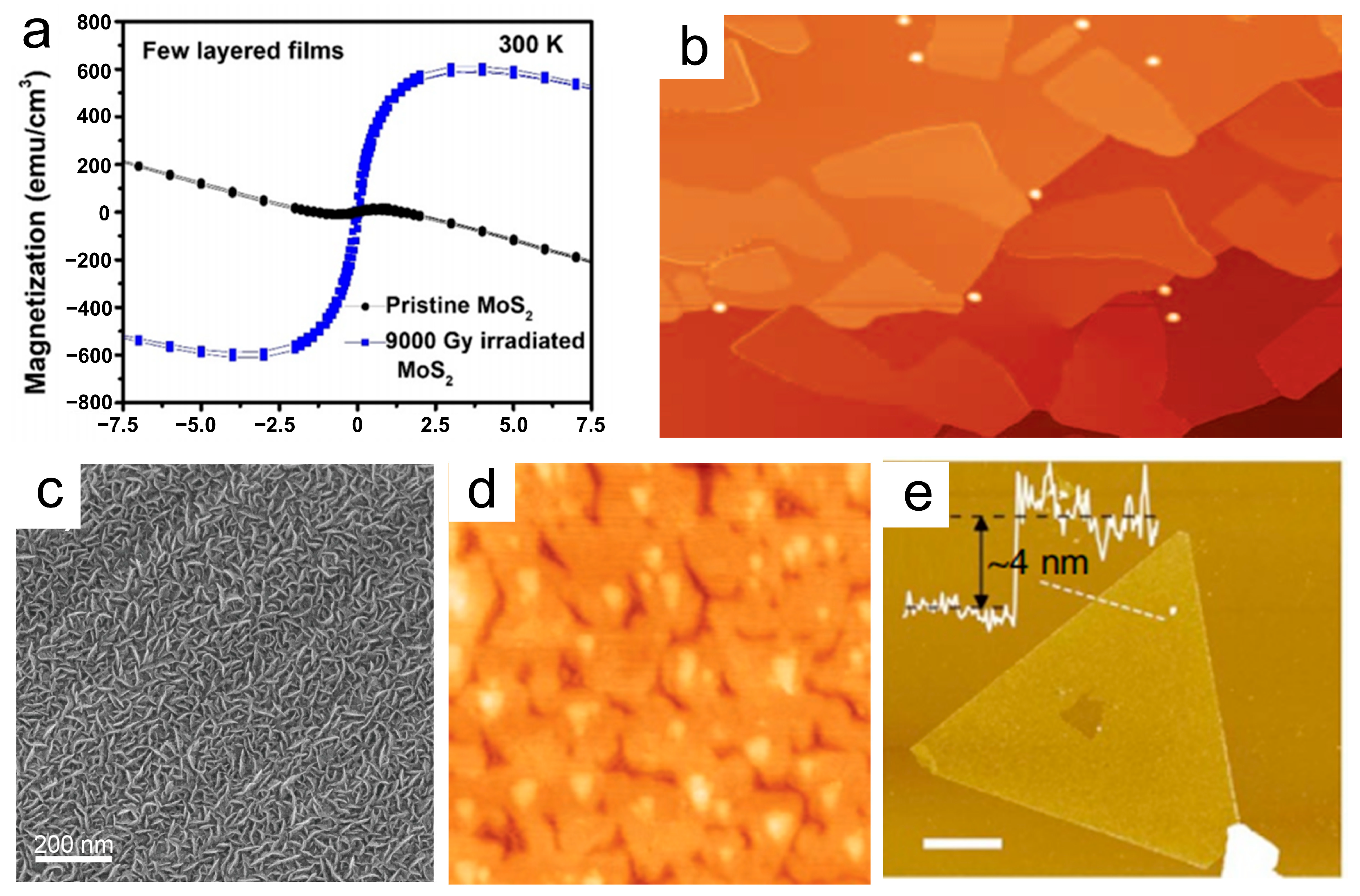
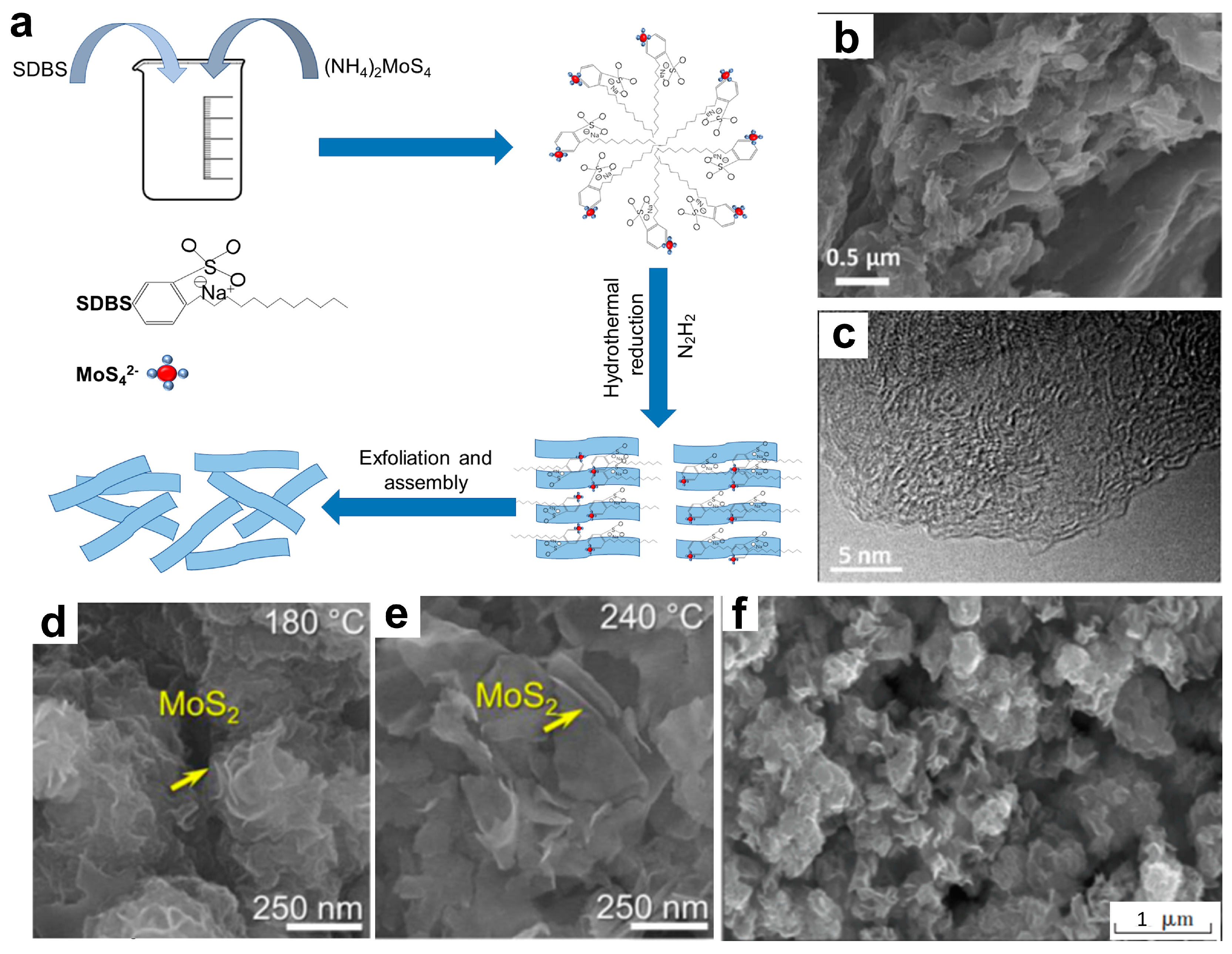
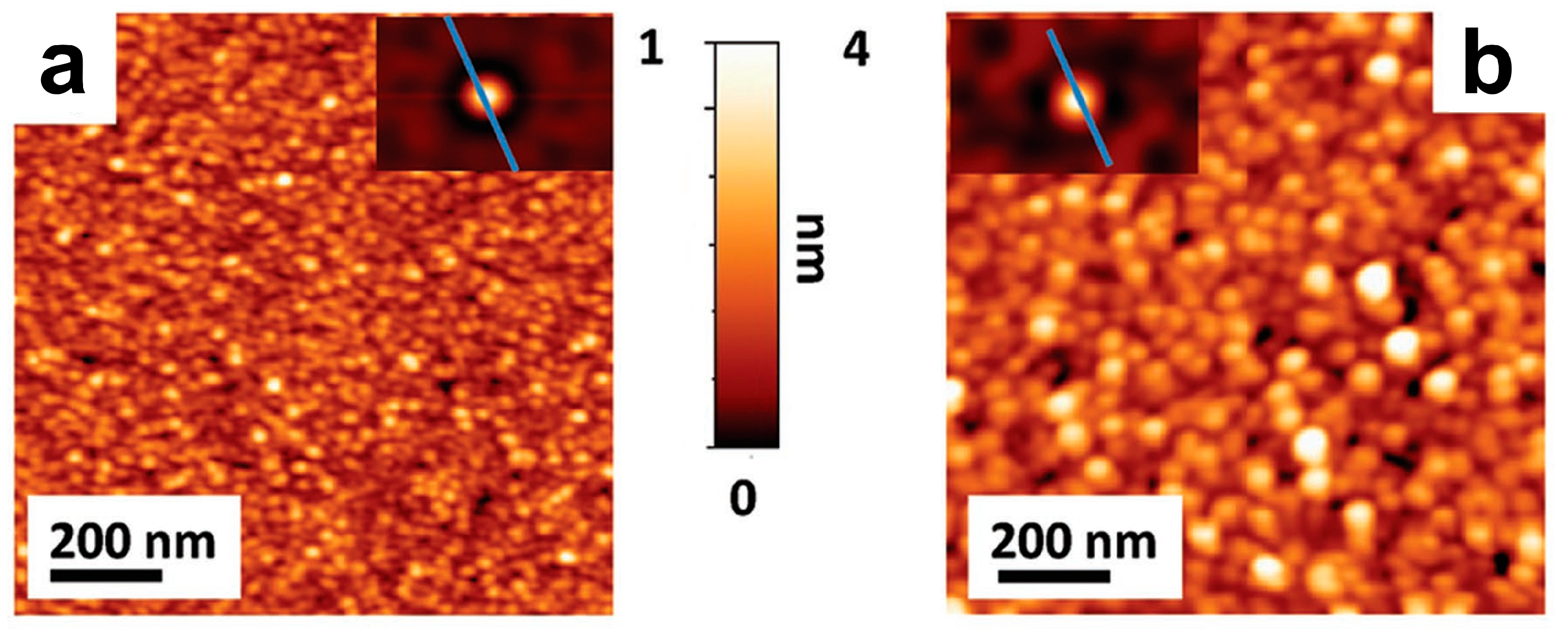


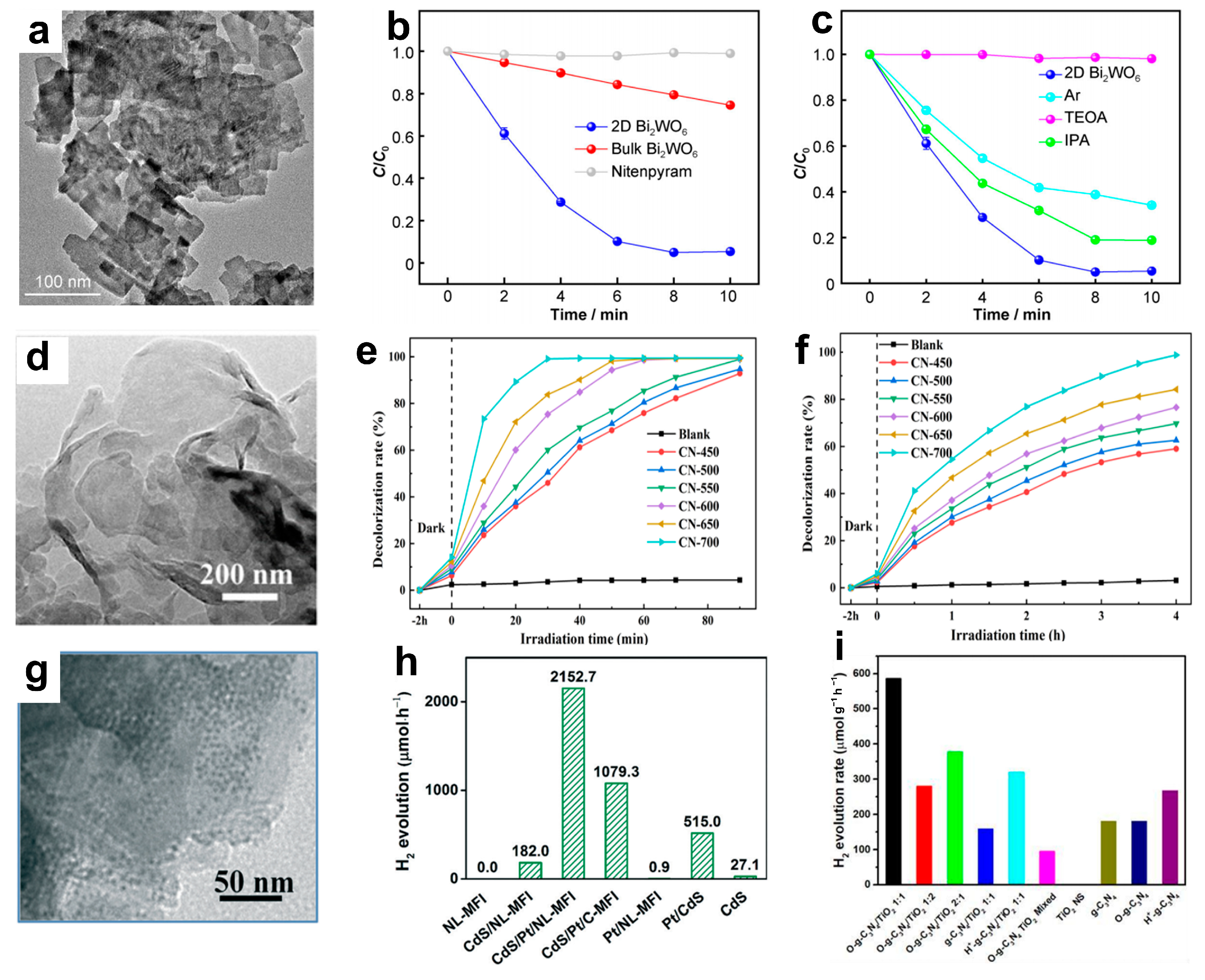
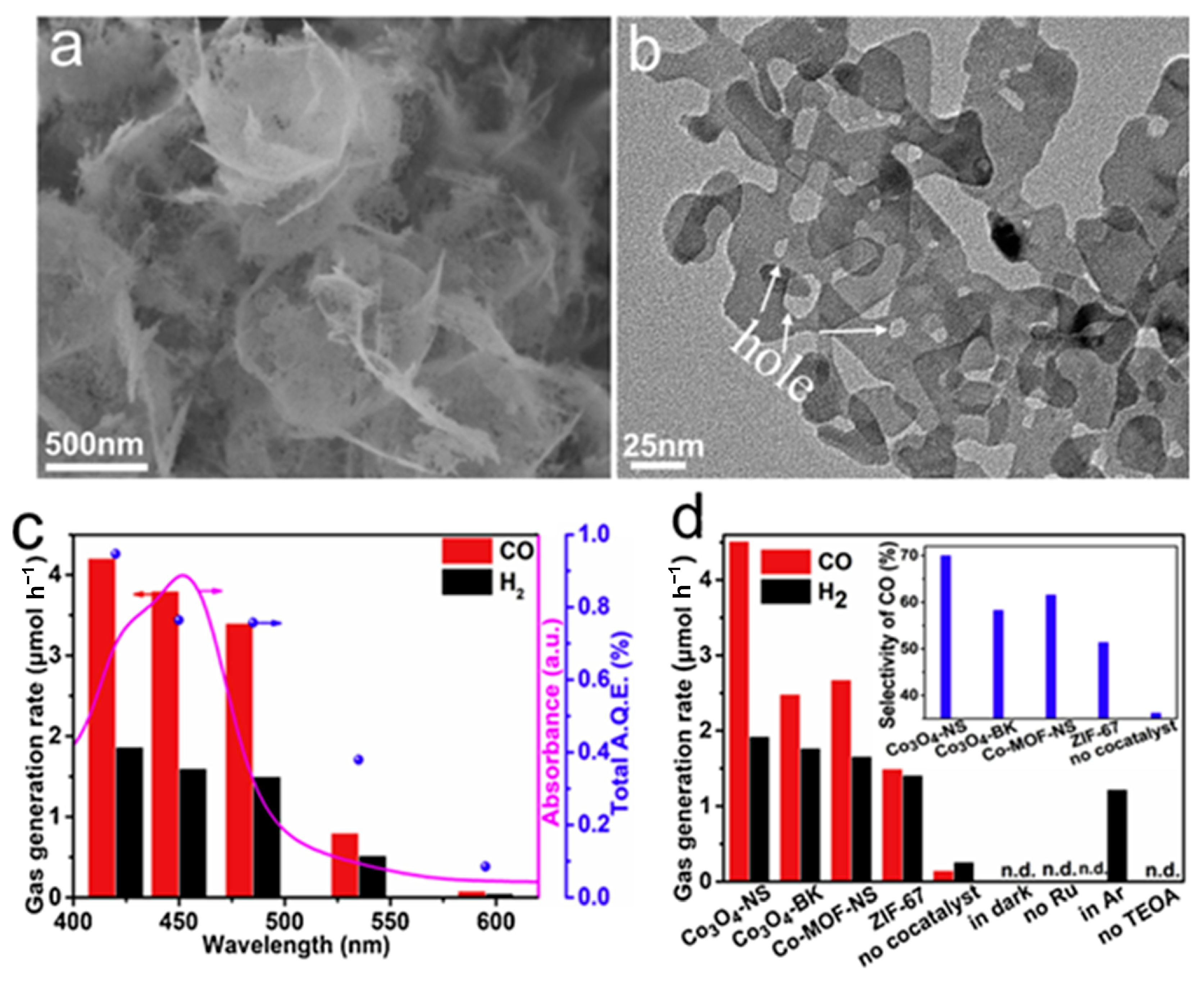

| Method | Advantage | Disadvantage | |
|---|---|---|---|
| Top-down method | Mechanical peeling | High sample purity, cost-effective | Low yield, poor controllability |
| Ultrasonic-assisted liquid phase exfoliation | Altering the solvents affects the morphology and size, simple process | small sample size, Low yield, structural damage | |
| Ion intercalation-assisted exfoliation | High yield, high quality, | Poor controllability, structural damage, | |
| Bottom-up method | Chemical vapor deposition | Pollution avoidance, excellent controllability | High costs, low reactant utilization rates |
| Physical vapor deposition | High purity, uniform film deposition, precise control | Limitations in material selection, high vacuum environment, relatively slow growth rates | |
| Hydrothermal strategy | Low cost, process stability | Prolonged reaction cycle, impure sample | |
| Atomic layer deposition | Precise control, uniformity, versatility | Slower growth rate, equipment complexity, restricted reaction condition | |
Disclaimer/Publisher’s Note: The statements, opinions and data contained in all publications are solely those of the individual author(s) and contributor(s) and not of MDPI and/or the editor(s). MDPI and/or the editor(s) disclaim responsibility for any injury to people or property resulting from any ideas, methods, instructions or products referred to in the content. |
© 2023 by the authors. Licensee MDPI, Basel, Switzerland. This article is an open access article distributed under the terms and conditions of the Creative Commons Attribution (CC BY) license (https://creativecommons.org/licenses/by/4.0/).
Share and Cite
Guo, Y.-T.; Yi, S.-S. Recent Advances in the Preparation and Application of Two-Dimensional Nanomaterials. Materials 2023, 16, 5798. https://doi.org/10.3390/ma16175798
Guo Y-T, Yi S-S. Recent Advances in the Preparation and Application of Two-Dimensional Nanomaterials. Materials. 2023; 16(17):5798. https://doi.org/10.3390/ma16175798
Chicago/Turabian StyleGuo, Ying-Tong, and Sha-Sha Yi. 2023. "Recent Advances in the Preparation and Application of Two-Dimensional Nanomaterials" Materials 16, no. 17: 5798. https://doi.org/10.3390/ma16175798
APA StyleGuo, Y.-T., & Yi, S.-S. (2023). Recent Advances in the Preparation and Application of Two-Dimensional Nanomaterials. Materials, 16(17), 5798. https://doi.org/10.3390/ma16175798





